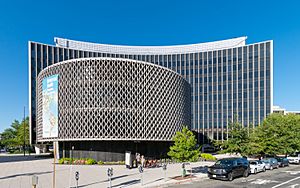Pan American Health Organization facts for kids
Quick facts for kids  Pan American Health Organization Organización Panamericana de la Salud (Spanish) Organização Pan-Americana da Saúde (Portuguese) |
|
|---|---|

Flag of the World Health Organization
|
|
| Org type | Specialized agency of the United Nations and Organization of American States |
| Headquarters | Washington, D.C., United States |
|
Pan American Health Organization
|
|
|---|---|
| Membership | 35 Member States and 4 Associate Members in the Americas |
| Leaders | |
|
• Director
|
Jarbas Barbosa |
|
• Deputy Director
|
Mary Lou Valdez |
|
• Assistant Director
|
Rhonda Sealey-Thomas |
| Establishment | 2 December 1902 |
|
Website
www.paho.org |
|
The Pan American Health Organization (PAHO) is a special group that works to improve health for everyone in the Americas. It is part of the United Nations (UN) and the Organization of American States. Think of it as a team of health experts for North, Central, and South America, and the Caribbean.
PAHO helps countries work together to fight diseases, make hospitals and clinics better, and respond to emergencies like hurricanes or earthquakes. It has 35 member countries and is headquartered in Washington, D.C. In Spanish-speaking countries, it's known as OPS, and in Portuguese-speaking countries, it's called OPAS.
Contents
What Does PAHO Do?
PAHO's main mission is to help the people of the Americas live healthier lives. It works with governments, universities, community groups, and other organizations to reach this goal.
PAHO has experts at its main office, in 27 country offices, and at three special centers. These experts help countries with their biggest health challenges.
Fighting Diseases
PAHO helps countries fight both infectious diseases that can spread, like malaria and dengue, and long-term illnesses like heart disease and cancer. It also works to stop the spread of diseases like HIV and tuberculosis.
One of its key strategies is promoting healthy habits. This includes helping people make smart choices about food and avoid harmful activities.
Making Healthcare Better
A big goal for PAHO is to make sure everyone can get good healthcare, no matter who they are or where they live. This is called universal health coverage. PAHO helps countries build strong health systems, starting with good local clinics and doctors.
PAHO also promotes using science and research to make smart health decisions. It helps countries share knowledge and find the best ways to keep people healthy.
Big Success Stories
PAHO has led many successful health projects. These successes show how powerful it is when countries work together.
Getting Rid of Diseases
One of PAHO's greatest achievements was getting rid of smallpox in the Americas in 1973. This was a huge victory that helped lead to the end of smallpox worldwide.
In 1985, PAHO started a major effort to end polio. By 1994, the Americas were declared polio-free. The last case was in a young boy from Peru in 1991. Now, PAHO is close to eliminating measles from the region as well.
Helping Children
PAHO works hard to save the lives of children. It helps provide vaccines to prevent sickness. It also teaches doctors and nurses how to treat common childhood problems like diarrheal diseases and breathing infections. This saves hundreds of thousands of young lives every year.
Working Together
For over 20 years, countries in Latin America and the Caribbean have joined together through PAHO to buy vaccines at a lower cost. This teamwork saves money and makes sure more people can get protected from diseases.
When disasters like Hurricane Mitch hit Central America, PAHO helped organize the health response, showing the power of countries helping each other in times of need.
A Brief History of PAHO
The organization was founded in December 1902, making it the world's oldest international public health agency. It was first called the Pan-American Sanitary Bureau.
In 1949, it officially became the American Regional Office for the World Health Organization (WHO). This means it is the part of the WHO that focuses specifically on the Americas.
The PAHO Headquarters Building
The main office of PAHO is in a unique building in Washington, D.C. In 1961, Uruguayan architect Román Fresnedo Siri won a competition to design it. The building is known for its modern style.
It is made of two parts: a curved ten-story office building and a round, four-story building for meetings. The outside of the building has 29 round bronze seals, each representing one of the founding nations of PAHO.
Public Health Heroes of the Americas
PAHO gives a special award to people who have made amazing contributions to public health in the Americas. This award is called "Public Health Hero" and is PAHO's highest honor.
Here are some of the people who have received this award:
- Dr. Tabaré Vázquez (Uruguay)
- Dr. Merceline Dahl-Regis (Bahamas)
- Dr. María Isabel Rodríguez (El Salvador)
- Dr. Ciro de Quadros (Brazil)
- Dr. Jacinto Convit (Venezuela)
- Hon. Marc Lalonde (Canada)
- Dr. Donald A. Henderson (US)
List of PAHO Directors
PAHO has been led by many dedicated directors since it was founded.
See also
- Pan American Journal of Public Health
- Vaccination Week In The Americas



